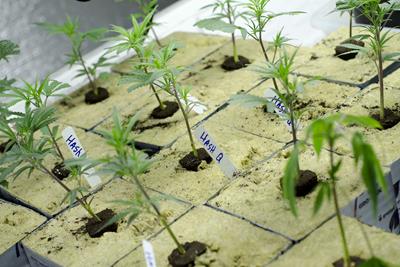
Saturday March 12, 2016
 Growing
Growing
Cannabis Companion planting
As any marijuana grower knows, some pests love the taste of cannabis and will quickly infest a growing area if given the opportunity. Although indoor growers can take steps to sterilize a growing environment and protect against pests, for the outdoor marijuana grower, protecting their precious pot from unwelcome intruders can be a bit of a nightmare.
Fortunately, there is a way to naturally protect cannabis seedlings and crops from pests while improving soil quality, supplementing nutrients and conserving grow space. This beneficial way of growing is called companion planting.
What is Companion Planting?
Companion planting is a process in which the conditions of a growing environment are improved by planting beneficial plants close to one another. Individual plants protect others against pests by emitting a strong odor (that will either deter pests directly or invite beneficial predators into the garden area). Other plants will actually improve soil conditions through aeration and nutrient promotion, while a select few will provide structural support and reduce the need for additional space.
For companion planting to be effective, however, complementary plants must be planted close together (but not too close) for the plants to benefit each other without having to compete for root space and other resources.
Companion Plants your Cannabis will Love
THC is a natural repellent that deters hundreds of pests. Unfortunately, many common garden pests are not dissuaded by the psychotropic qualities of this popular cannabinoid. For this reason, supplemental pest protection is recommended lest the crop be littered with diseased plants and the harvest be covered in tiny spider mite webs.
Rather than use chemical-based pesticides that have not been approved for either cannabis consumption or combustion, use these popular garden plants to deter pests and encourage rapid garden growth in outdoor gardens of all sizes.
-
Basil
Basil is a common garden favorite because its strong scent repels garden pests like thrips, aphids, beetles and flies. It is also thought to increase the oil production and improve the flavor of nearby plants (though the hours of wading through forum posts has been inconclusive in confirming this). -
Beans
Nitrogen is one of the most common deficiencies in cannabis cultivation, which can lead to a discoloration of the leaves followed by slow leaf death. Planting beans near a cannabis plant can help remedy that. With the ability to pull nitrogen out of the air and transform it into nitrites to be used by cannabis, growing beans amidst a cannabis crop can help the harvest grow vigorous and healthy, and can provide an excellent snack to boot. -
Garlic
Garlic is a powerful addition to any garden because it deters both great and small pests and works as a natural fungicide to protect against disease. It can be planted near cannabis or used topically in a spray as a spot-treatment. -
Marigolds
Who can resist the sweet smell of marigold flowers? Their bright colors and the fragrant scent makes them especially appealing to tiny pests who might otherwise be chomping on your cannabis. Plant a few around the perimeter of your cannabis plot to entice pests to visit them instead of your sweet Mary Jane. -
Mint
Mint is another plant with a strong odor that is less-than-appealing to most garden pests. It can also help mask the smell of freshly-blooming buds if privacy is a concern. Just remember that mint tends to be very invasive so planting it in pots near your cannabis, rather than directly in the ground, is highly recommended. -
Peppers
Chili peppers will deter large pests like deer, rabbits, and mice. The root system of peppers also exudes a chemical that protects against rot which is especially favorable in areas with excess rainfall or poor drainage.
With growing concern for pesticide use in cannabis, many home growers are opting for an at-home, organic approach to medicine cultivation. But keeping things natural by avoiding chemical-based fertilizers and pesticides while still protecting crops against pests can be tricky. Many insects, rodents, and other small animals are drawn to cannabis like we are, so it’s important to diligently monitor the condition of your marijuana grow throughout its whole cycle. The process takes work, but can be simplified by a simple addition of a few choice plants and flowers.







